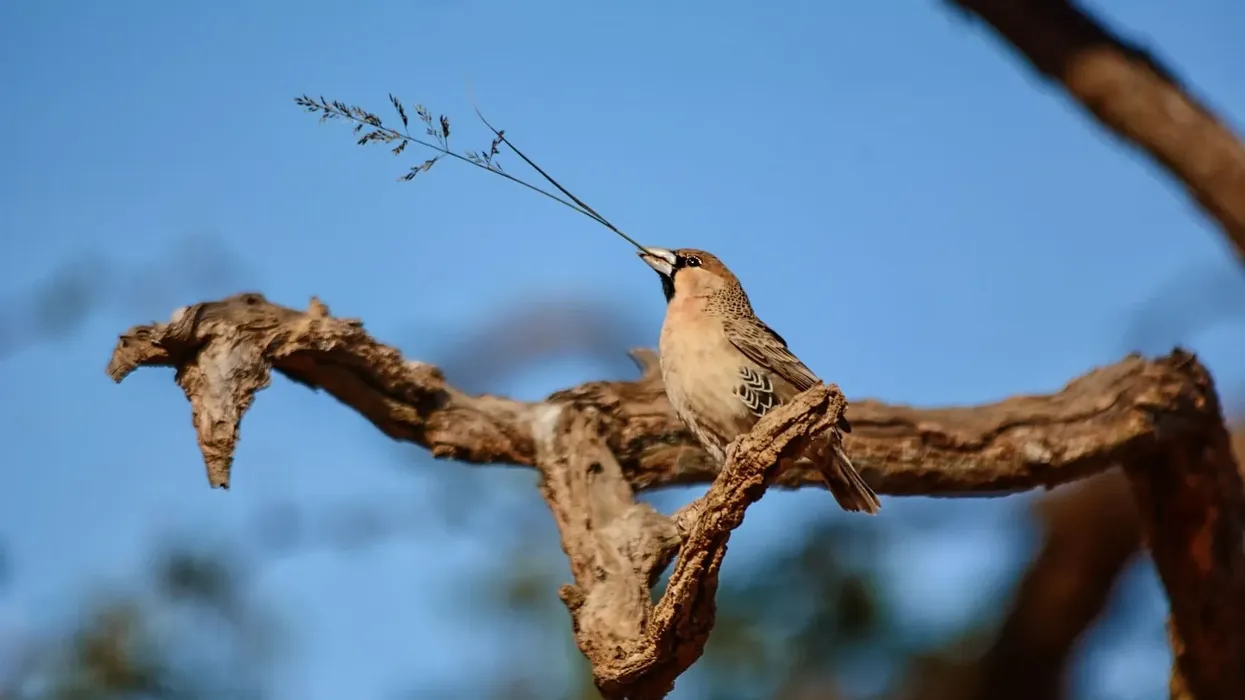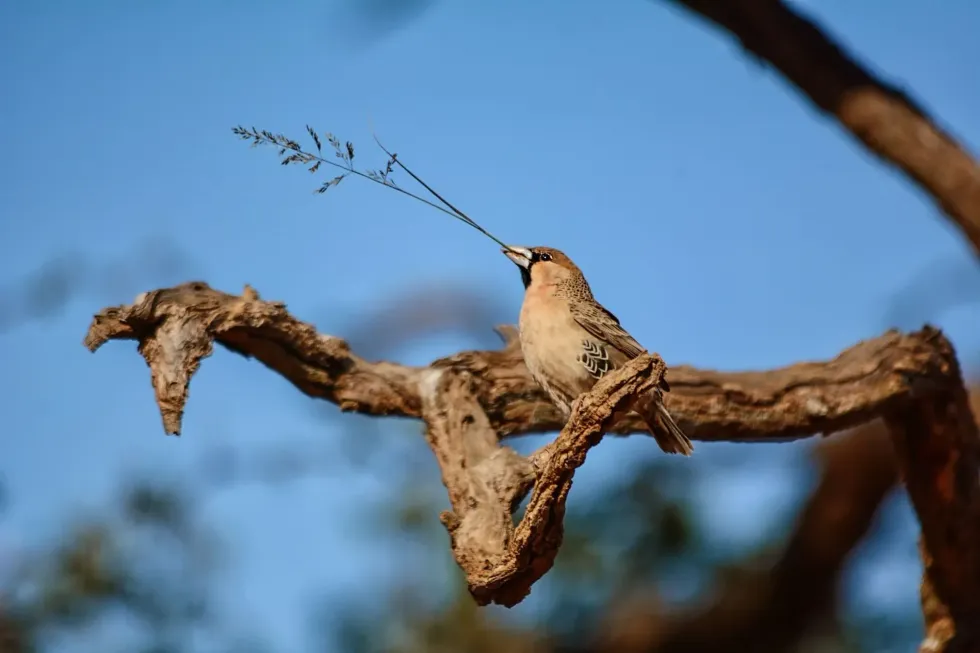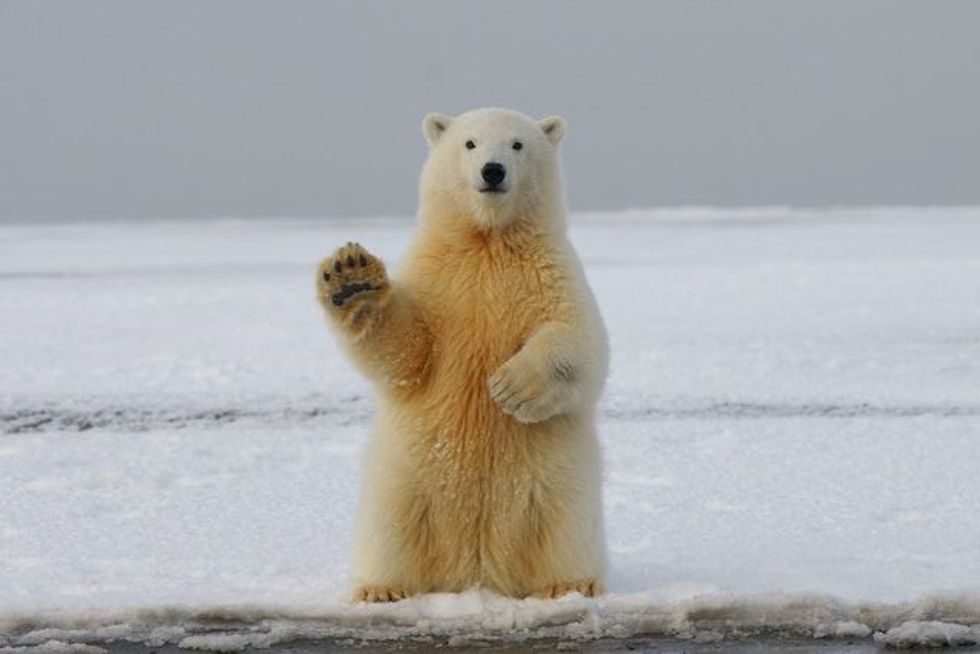The Clarke's weaver is a rare species that is endemic to the Sokoke-Arabuko forest and the Dakatcha woodland of Kenya. The scientific name of this species is Ploceus golandi, and they belong to the Ploceidae family of the order Passeriformes.
These birds are very rare, and it is extremely hard to spot them in their natural habitat. Their natural habitat includes thick tropical forest, tropical lowland and open woodland.
Until recently, there was almost no information about the Clarkes weaver migration pattern. However, it was discovered that during the months of April to July, these birds migrate from the Sokoke-Arabuko to the open Dakatcha woodland to nest.
They form large, active feeding flocks with the feeding flocks of different species. In fact, this species is so rare that the only way to find them is to follow these large feeding and breeding groups.
Due to their rareness and dwindling numbers, this species has been given the Endangered status by the IUCN. Hence, in order to stabilize the population of these tropical birds, various conservation steps have been taken in Kenya.
These birds are characterized by their bright yellow underbellies and black heads. They are also known for their unique song, and mysterious breeding patterns.
For more relatable content, check out these bee eater facts and cockatoo facts for kids.
Clarke's Weaver Interesting Facts
What type of animal is a Clarke's weaver?
The Clarke's weaver (Ploceus golandi) is a species of bird belonging to the Ploceidae family of the class Aves.
What class of animal does a Clarke's weaver belong to?
The Clarke's weaver (Ploceus golandi) is a bird.
How many Clarke's weavers are there in the world?
It has been estimated that the current Clarke's weaver (Ploceus golandi) population is in the range of 2000-4000 birds.
Where does a Clarke's weaver live?
The Clarke's weaver (Ploceus golandi) is only found in the Kilifi County of Kenya. Hence, it is considered endemic to the Kenyan forests.
What is a Clarke's weaver's habitat?
The Clarkes weaver habitat consists of lowland, tropical foresty areas, dense foliage, and seasonal woodlands.
Who do Clarke's weavers live with?
Clarke's weavers live together in groups that range from 300-700 birds of the same species. In Dakatcha, researchers observed a population of a whopping 700 birds of this species nesting in a wetland.
How long does a Clarke's weaver live?
The exact lifespan of the Clarke's weaver (Ploceus golandi) is not known. However, based on the lifespan of other weaver birds, it can be speculated that the Clarke's weaver can live between a range of 10-15 years.
How do they reproduce?
This species reproduces oviparously. This means that they reproduce using eggs. There was not much known recently about the reproduction and nesting habits of the Clarke's Weaver. However, it has been discovered that 700 members of this species nest in the Dakatcha woodlands. The Clarke's weaver nest was found to be made out of sedge.
What is their conservation status?
The Clarke's weaver has been given the Endangered status by the IUCN.
Clarke's Weaver Fun Facts
What do Clarke's weavers look like?
Clarke's weavers are characterized by their long bills and yellow feathers. The male Clarke's weavers color is a bright, yellow with a black head. Females, on the other hand, have a yellow head with a pale yellow belly. They also have black feathers with yellow tips.
*We've been unable to source an image of a Clarke's weaver and have used an image of a sociable weaver instead. If you are able to provide us with a royalty-free image of a Clarke's weaver, we would be happy to credit you. Please contact us at hello@kidadl.com.

How cute are they?
Clarke's weavers are considered to be very cute and very beautiful. The combination of black and yellow feathers looks breathtaking while they are in flight. However, it is extremely rare to spot this species. In fact, it was considered to be very hard to obtain a Clarkes weaver photo.
How do they communicate?
This species communicates by means of auditory signals. These endangered birds are known for their unique calls that often sound like radio static, or a 'Chek' sound. These birds are engaged in active flocks, and they all emit their song together like a concert.
How big is a Clarke's weaver?
The Clarke's weaver can grow anywhere in the range of 5.11-5.51 in (13-14 cm) by length. This makes them almost two times smaller than the ovenbird.
How fast can a Clarke's weaver fly?
The exact speed of a Clarke's weaver is unknown. However, they are said to be very quick and agile.
How much does a Clarke's weaver weigh?
The exact weight of this species is not known.
What are the male and female names of the species?
There are no specific names for the males and females of this species. They are simply referred to as Clarke's weaver male or Clarke's weaver female.
What would you call a baby Clarke's weaver?
A baby Clarke's weaver is referred to as a juvenile or a chick.
What do they eat?
Clarke's weavers are carnivorous in nature and eat worms, caterpillars, ants, beetles and other small insects.
Are they poisonous?
No, the Clarke's weaver is not poisonous. They are small and harmless birds that rely on foraging for food.
Would they make a good pet?
Clarke's weavers are highly endangered wild animals. Due to this, they are highly protected by the Kenyan government and the Dakatcha woodland conservation group. As a result, these birds are not allowed to be held captive as pets.
Did you know...
This species is the most abundant in the Brachystegia forest, specifically in the white sand soil areas of the forest. They are also commonly found in the Sokoke forest.
This species can be found in loud and active feeding flocks of 5-3 birds in the Brachystegia forest. These feeding flocks are usually intermixed with feeding flocks of different bird species.
This species is often very hard to spot, especially in its natural habitat. In fact, until recently, their breeding patterns and nesting grounds remained a mystery to the people of Kenya.
However, if you really do want to spot a member of this species in its natural habitat in the forest, you should find one of these large multi-species feeding flocks in the forest, and follow them until they lead you to a Clarke's weaver.
This species is endemic to Kenya, which means that the only place in the world that they can be found naturally in is Kenya. They are specifically endemic to the Arabuko-Sokoke Forest of Kenya, and this is considered to be the most important natural site for this species.
Hence, disrupting the natural forest habitat of this species is highly illegal, and punishable by jail time.
In fact, this forest is a highly protected forest as many conservation efforts are being taken to stabilize the population of this species in Kenya. Any act against the conservation steps being taken, or any act that disrupts the habitat of this species is highly illegal.
Although this species is most frequent in the Arabuko-Sokoke forest, they do not breed there. In fact, from the months of April to July, this species cannot be found in this forest.
It can be assumed that they breed and nest elsewhere, such as in the Dakatcha woodlands. This species only has a very scattered population in the Dakatcha woodlands, but they are known for their active feeding flocks and breeding groups in this area.
Following the discovery of this species by the Clarke brothers in the year 1913, they were not sighted again for nearly four decades. Due to this, scientists believed that this species was merely an aberrant version of an existing Weaver in Kenya.
However, in 1955, this species was discovered again in the Sokoke forest of Kenya.
Following this, many samples were collected and various feeding flocks were discovered, and this species was finally declared as a valid species that is endemic to Kenya. Other species endemic to Africa include the African Penguin, Secretary bird and Gelada.
Are Clarke's weavers endangered?
Yes, the Clarke's weaver (Ploceus golandi) has been classified as endangered by the IUCN due to habitat loss. They are also only found in Kenya and nowhere else in the world.
In a bid to protect this species, the Dakatcha woodland conservation group has been taking up various conservation efforts to protect the only breeding ground of this species. In addition to this, Nature Kenya is an organization that has been actively working towards conserving and increasing the Clarke's weaver population in Dakatcha.
How did Clarke's weavers get their name?
Stephenson Robert Clarke, a passionate naturalist, and collector, discovered and identified the Clarke's Weaver species. On a shooting expedition to Kenya in 1913, Stephenson Clarke and his younger brother collected various samples of the birdlife in Kenya. This is when they discovered the Clarke's weaver species, which he named after his brother.
Here at Kidadl, we have carefully created lots of interesting family-friendly animal facts for everyone to discover! For more relatable content, check out these blue jay facts and hummingbird facts pages.
You can even occupy yourself at home by coloring in one of our free printable bird coloring pages.








